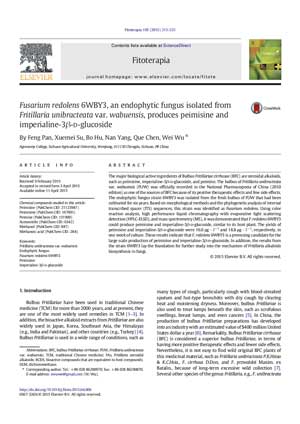NEWS 2015
Fusarium redolens 6WBY3, an endophytic fungus isolated from Fritillaria unibracteata var. wabuensis, produces peimisine and imperialine-3β-d-glucoside
Feng PAN, Xuemei SU, Bo HU, Nan YANG, Que CHEN, Wei WU
Fitoterapia 103: 213–221 (2015)
doi: 10.1016/j.fitote.2015.04.006
Agronomy College, Sichuan Agricultural University, Wenjiang, 611130 Chengdu, Sichuan, PR China
Abstract
The major biological active ingredients of Bulbus Fritillariae cirrhosae (BFC) are steroidal alkaloids, such as peimisine, imperialine-3β-d-glucoside, and peimine. The bulbus of Fritillaria unibracteata var. wabuensis (FUW) was officially recorded in the National Pharmacopoeia of China (2010 edition) as one of the sources of BFC because of its positive therapeutic effects and few side effects. The endophytic fungus strain 6WBY3 was isolated from the fresh bulbus of FUW that had been cultivated for six years. Based on morphological methods and the phylogenetic analysis of internal transcribed spacer (ITS) sequences, this strain was identified as Fusarium redolens. Using color reaction analysis, high performance liquid chromatography with evaporative light scattering detection (HPLC-ELSD), and mass spectrometry (MS), it was demonstrated that F. redolens 6WBY3 could produce peimisine and imperialine-3β-d-glucoside, similar to its host plant. The yields of peimisine and imperialine-3β-d-glucoside were 16.0 μg · l-¹ and 18.8 μg · l-¹, respectively, in one week of culture. These results indicate that F. redolens 6WBY3 is a promising candidate for the large scale production of peimisine and imperialine-3β-d-glucoside. In addition, the results from the strain 6WBY3 lay the foundation for further study into the mechanism of Fritillaria alkaloids biosynthesis in fungi.

